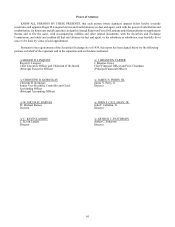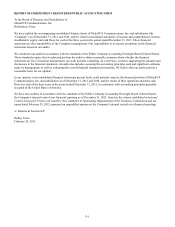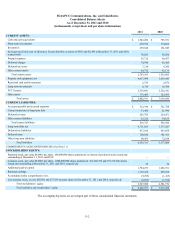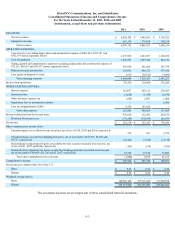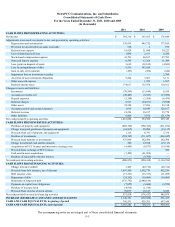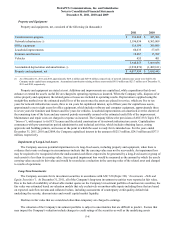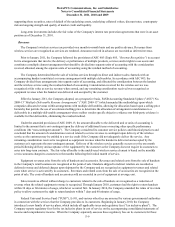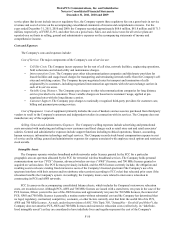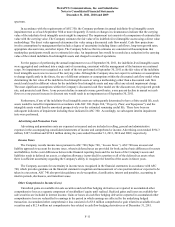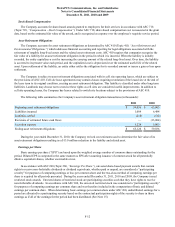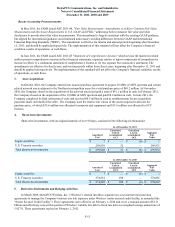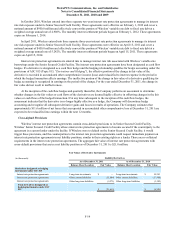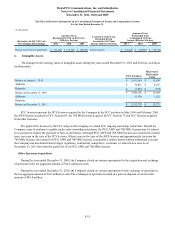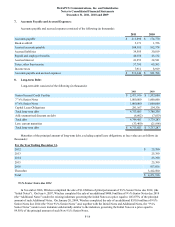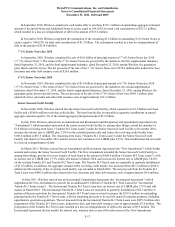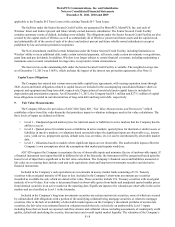Metro PCS 2011 Annual Report Download - page 115
Download and view the complete annual report
Please find page 115 of the 2011 Metro PCS annual report below. You can navigate through the pages in the report by either clicking on the pages listed below, or by using the keyword search tool below to find specific information within the annual report.MetroPCS Communications, Inc. and Subsidiaries
Notes to Consolidated Financial Statements
December 31, 2011, 2010 and 2009
F-9
supporting those securities, rates of default of the underlying assets, underlying collateral values, discount rates, counterparty
risk and ongoing strength and quality of market credit and liquidity.
Long-term investments includes the fair value of the Company's interest rate protection agreements that were in an asset
position as of December 31, 2010.
Revenues
The Company's wireless services are provided on a month-to-month basis and are paid in advance. Revenues from
wireless services are recognized as services are rendered. Amounts received in advance are recorded as deferred revenue.
Prior to January 2011, the Company followed the provisions of ASC 605 (Topic 605, “Revenue Recognition”) to account
for its arrangements that involve the delivery or performance of multiple products, services and/or rights to use assets and
constitutes a multiple element arrangement that should be divided into separate units of accounting with the consideration
received allocated among the separate units of accounting using the residual method of accounting.
The Company determined that the sale of wireless services through its direct and indirect sales channels with an
accompanying handset constituted a revenue arrangement with multiple deliverables. In accordance with ASC 605, the
Company divided these arrangements into separate units of accounting, and allocated the consideration between the handset
and the wireless service using the residual method of accounting. Consideration received for the wireless service was
recognized at fair value as service revenue when earned, and any remaining consideration received was recognized as
equipment revenue when the handset was delivered and accepted by the customer.
Effective January 2011, the Company adopted, on a prospective basis, FASB Accounting Standards Update ("ASU") No.
2009-13 “Multiple-Deliverable Revenue Arrangements” (“ASU 2009-13”) which amended the methodology upon which
companies allocated revenue within arrangements with multiple deliverables, allowing for allocation based upon a selling price
hierarchy that permits the use of an estimated selling price to determine the allocation of arrangement consideration to a
deliverable in a multiple-deliverable arrangement where neither vendor specific objective evidence nor third-party evidence is
available for that deliverable, eliminating the residual method.
Under the amended provisions of ASU 2009-13, the amount allocable to the delivered unit or units of accounting is
limited to the amount that is not contingent upon the delivery of additional items or meeting other specific performance
conditions (the “non-contingent amount”). The Company considered its customer service policies and historical practices and
concluded that the amount of consideration received related to service revenue is contingent upon delivery of the wireless
service as the customer may be entitled to a service credit if the Company did not adequately deliver the service. Any
remaining consideration received is recognized as equipment revenue when the handset is delivered and accepted by the
customer as it represents the non-contingent amount. Delivery of the wireless service generally occurs over the one month
period following delivery and acceptance of the equipment by the customer as the Company does not require its customers to
enter into long-term contracts. The fair value allocable to the undelivered wireless service element is based on the monthly
service amounts charged to customers in the months following their initial month of service.
Equipment revenues arise from the sale of handsets and accessories. Revenues and related costs from the sale of handsets
in the Company's retail locations are recognized at the point of sale. Handsets shipped to indirect retailers are recorded as
deferred revenue and deferred charges upon shipment by the Company and are recognized as equipment revenues and related
costs when service is activated by its customers. Revenues and related costs from the sale of accessories are recognized at the
point of sale. The costs of handsets and accessories sold are recorded in cost of equipment at average cost.
Sales incentives offered without charge to customers related to the sale of handsets are recognized as a reduction of
revenue when the related equipment revenue is recognized. Through January 2010, customers had the right to return handsets
within 30 days or 60 minutes of usage, whichever occurred first. In January 2010, the Company amended the terms of its return
policy to allow customers the right to return handsets within 7 days and 60 minutes of usage.
Federal Universal Service Fund (“FUSF”), E-911, and various other fees are assessed by various governmental authorities
in connection with the services that the Company provides to its customers. Beginning in January 2010, the Company
introduced a new family of service plans, which include all applicable taxes and regulatory fees (“tax inclusive plans”). The
Company reports regulatory fees for the tax inclusive plans in cost of service on the accompanying consolidated statements of
income and comprehensive income. When the Company separately assesses these regulatory fees on its customers for those



